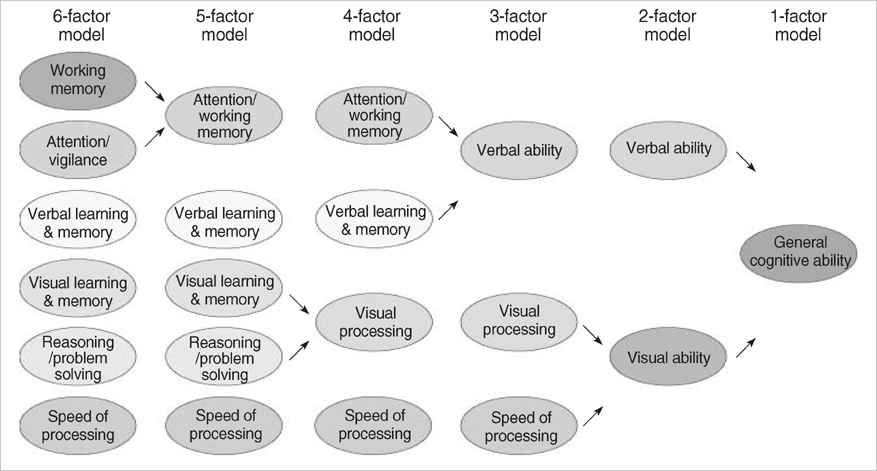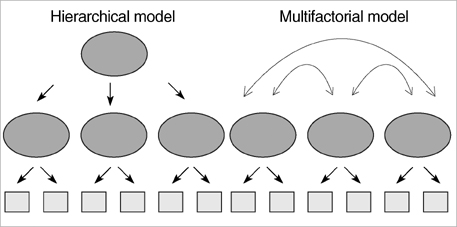J Korean Med Sci.
2010 Feb;25(2):276-282. 10.3346/jkms.2010.25.2.276.
Factor Structure of the Neurocognitive Tests: An Application of the Confirmative Factor Analysis in Stabilized Schizophrenia Patients
- Affiliations
-
- 1Samsung Biomedical Research Institute, Seoul, Korea.
- 2Department of Psychiatry, Samsung Medical Center, Sungkyunkwan University School of Medicine, Seoul, Korea. sechang.yoon@samsung.com
- 3Department of Psychology, Korea University School, Seoul, Korea.
- 4Seoul Metropolitan Eunpyoung Hospital, Seoul, Korea.
- KMID: 1779260
- DOI: http://doi.org/10.3346/jkms.2010.25.2.276
Abstract
- The purpose of the present study was to identify the factor structure of neurocognitive tests used on schizophrenia patients by using the confirmative factor analysis, and to assess the factor score differences of schizophrenia patients and healthy controls. Comprehensive neurocognitive tests were administered to stabilized schizophrenia patients (N=114) and healthy controls (N=120). In the results of factor analyses on patients, the multifactorial-6-factor model, which included the speed of processing, working memory, verbal learning and memory, visual learning and memory, attention/vigilance, and reasoning/problem solving as suggested by the Measurement and Treatment Research to Improve Cognition in Schizophrenia (MATRICS), showed the better goodness of fit than any of the other models tested. And assessing the group differences of factor scores, we found the patients performed worse than the controls in all factors, but the result showed meaningful variations of impairments across the cognitive factors. Our study identifies the six major domains with multifactorial structure of cognitive abilities in schizophrenia patients and confirms the distinctive impairment patterns of each cognitive domain. These results may have utility in better understanding the pathology of schizophrenia as well as in genetic studies.
MeSH Terms
Figure
Cited by 2 articles
-
Intra-Individual Neuropsychological Test Variability : A Comparison of Patients with Schizophrenia, Their Siblings, and Healthy Controls
Hyeji Oh, Kounseok Lee, Seunghyong Ryu, Jihae Noh, Juhyun Park, Hong Choi, Ji-Hae Kim, Kyung Sue Hong
J Korean Neuropsychiatr Assoc. 2014;53(6):379-385. doi: 10.4306/jknpa.2014.53.6.379.Correlation of Lifetime Symptom Dimensions with Cognitive Function and Other Clinical Characteristics in Schizophrenia Patients
Youngah Cho, Seunghyong Ryu, Hyeji Oh, Sohee Oh, Taesung Park, Se Chang Yoon, Kyung Sue Hong
Korean J Schizophr Res. 2014;17(2):72-79. doi: 10.16946/kjsr.2014.17.2.72.
Reference
-
1. Buchanan RW, Davis M, Goff D, Green MF, Keefe RS, Leon AC, Nuechterlein KH, Laughren T, Levin R, Stover E, Fenton W, Marder SR. A summary of the FDA-NIMH-MATRICS workshop on clinical trial design for neurocognitive drugs for schizophrenia. Schizophr Bull. 2005. 31:5–19.
Article2. Jaeger J, Czobor P, Berns SM. Basic neuropsychological dimensions in schizophrenia. Schizophr Res. 2003. 65:105–116.
Article3. Nuechterlein KH, Barch DM, Gold JM, Goldberg TE, Green MF, Heaton RK. Identification of separable cognitive factors in schizophrenia. Schizophr Res. 2004. 72:29–39.
Article4. Genderson MR, Dickinson D, Diaz-Asper CM, Egan MF, Weinberger DR, Goldberg TE. Factor analysis of neurocognitive tests in a large sample of schizophrenic probands, their siblings, and healthy controls. Schizophr Res. 2007. 94:231–239.
Article5. Nam HJ, Kim N, Park T, Oh S, Jeon HO, Yoon SC, Lee YS, Lee WK, Ha K, Kim JH, Hong KS. Cognitive profiles of healthy siblings of schizophrenia patients: application of the cognitive domains of the MATRICS consensus battery. World J Biol Psychiatry. 2009. 10:452–460.
Article6. Lee KJ, Wee W, Yoo SY, Lee AR, Song JY, Ha TH, Hong KS, Kim MS, Kwon JS. Cognition, emotion and social function: are vulnerability markers for developing schizophrenia? J Korean Neuropsychiatr Assoc. 2006. 45:3–10.7. Green MF, Nuechterlein KH. The MATRICS initiative: developing a consensus cognitive battery for clinical trials. Schizophr Res. 2004. 72:1–3.
Article8. Nuechterlein KH, Green MF, Kern RS, Baade LE, Barch DM, Cohen JD, Essock S, Fenton WS, Frese FJ 3rd, Gold JM, Goldberg T, Heaton RK, Keefe RS, Kraemer H, Mesholam-Gately R, Seidman LJ, Stover E, Weinberger DR, Young AS, Zalcman S, Marder SR. The MATRICS Consensus Cognitive Battery, part 1: test selection, reliability, and validity. Am J Psychiatry. 2008. 165:203–213.
Article9. Dickinson D, Ragland JD, Calkins ME, Gold JM, Gur RC. A comparison of cognitive structure in schizophrenia patients and healthy controls using confirmatory factor analysis. Schizophr Res. 2006. 85:20–29.
Article10. Joo EJ, Joo YH, Hong JP, Hwang S, Maeng SJ, Han JH, Yang BH, Lee YS, Kim YS. Korean version of the diagnostic interview for genetic studies: validity and reliability. Comprehensive Psychiatry. 2004. 45:225–229.
Article11. Tabachnick BG, Fidell LS. Using Multivariate Statistics. 2001. New York: HarperCollins.12. Spearman C. The Abilities of Man: Their Nature and Measurement. 1927. New York: Macmillan.13. Wechsler D. Measurement of Adult Intelligence. 1939. Baltimore: Williams & Wilkins.14. Wechsler D. Wechsler Adult Intelligence Scale-Third Edition (WAIS-III). 1997. San Antonio: Psychological Corporation.15. Wechsler D. Wechsler Intelligence Scale for Children (WISC-IV)-Fourth Edition. 2003. San Antonio: Psychological Corporation.16. Kaufman AS, Lichtenberger EO. Essentials of WAIS-III Assessment. 1999. New York: John Wiley & Sons.17. McGrew KS. Flanagan DP, Genshaft JL, Harrison PL, editors. Analysis of the major intelligence batteries according to a proposed comprehensive Gf-Gc framework. Contemporary Intellectual Assessment: Theories, Tests, and Issues. 1997. New York: Guilford Press;151–179.18. Gladsjo JA, McAdams LA, Palmer BW, Moore DJ, Jeste DV, Heaton RK. A six-factor model of cognition in schizophrenia and related psychotic disorders: relationships with clinical symptoms and functional capacity. Schizophr Bull. 2004. 30:739–754.
Article19. Cole DA. Utility of confirmatory factor analysis in test validation research. J Consult Clin Psychol. 1987. 55:584–594.
Article20. Bollen KA, Stine RA. Bootstrapping goodness-of-fit measures in structural equation models. Sociologic Methods Res. 1992. 21:205–229.
Article21. Saykin AJ, Gur RC, Gur RE, Mozley PD, Mozley LH, Resnick SM, Kester DB, Stafiniak P. Neuropsychological function in schizophrenia. Selective impairment in memory and learning. Arch Gen Psychiatry. 1991. 48:618–624.22. Wainer H. Estimating coefficients in linear models: It don't make no nevermind. Psychological Bulletin. 1976. 83:213–217.
Article23. Byrne BM. A primer of LISREL: basic applications and programming for confirmatory factor analytic model. 1989. New York: Springer-Verla;55.24. Carter CS, Barch DM, Buchanan RW, Bullmore E, Krystal JH, Cohen J, Geyer M, Green M, Nuechterlein KH, Robbins T, Silverstein S, Smith EE, Strauss M, Wykes T, Heinssen R. Identifying cognitive mechanisms targeted for treatment development in schizophrenia: an overview of the first meeting of the Cognitive Neuroscience Treatment Research to Improve Cognition in Schizophrenia Initiative. Biol Psychiatry. 2008. 64:4–10.
Article25. Silver H, Shmoish M. Analysis of cognitive performance in schizophrenia patients and healthy individuals with unsupervised clustering models. Psychiatry Res. 2008. 159:167–179.
Article26. Klingberg S, Wittorf A, Sickinger S, Buchkremer G, Wiedemann G. Course of cognitive functioning during the stabilization phase of schizophrenia. J Psychiatr Res. 2008. 42:259–267.
Article27. Aleman A, Hijman R, de Haan EH, Kahn RS. Memory impairment in schizophrenia: a meta-analysis. Am J Psychiatry. 1999. 156:1358–1366.28. Sanchez P, Ojeda N, Pena J, Elizagarate E, Yoller AB, Gutierrez M, Ezcurra J. Predictors of longitudinal changes in schizophrenia: the role of processing speed. J Clin Psychiatry. 2009. 70:888–896.29. Albus M, Hubmann W, Mohr F, Hecht S, Hinterberger-Weber P, Seitz NN, Kuchenhoff H. Neurocognitive functioning in patients with first-episode schizophrenia: results of a prospective 5-year follow-up study. Eur Arch Psychiatry Clin Neurosci. 2006. 256:442–451.30. Barch DM, Carter CS. Measurement issues in the use of cognitive neuroscience tasks in drug development for impaired cognition in schizophrenia: a report of the second consensus building conference of the CNTRICS initiative. Schizophr Bull. 2008. 34:613–618.
Article
- Full Text Links
- Actions
-
Cited
- CITED
-
- Close
- Share
- Similar articles
-
- Psychometric Properties of the Mental Health Continuum-Short Form (MHC-SF): A Study With Individuals With Schizophrenia Living in the Community
- Neurophyisological and Neurocognitive Endophenotypes for Schizophrenia Genetics Research
- Factor Analysis of the Adolescent Personality Assessment Inventory
- The Reliability and Validity of the Korean Version of Apathy Evaluation Scale and its Application in Patients with Schizophrenia
- Factor Analysis of K-WAIS in a Sample of Patients with Organic Mental Disorder due to Head Trauma



